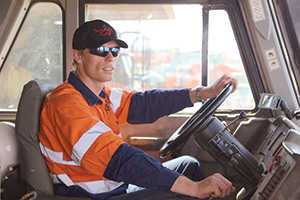New Tech Tools Can Help Fleets Monitor Driver Health, Fatigue

This story appears in the May 9 print edition of Transport Topics.
CINCINNATI — The push to monitor the performance of truck drivers may soon extend beyond cameras in the cab and electronic logs.
Technology in the near future could include devices that can measure drivers’ pulse and heart rate and even their “state of mind” as fleet managers look for ways to better manage fatigue and control behaviors, such as texting while driving, that can be a predictor of crashes.
At the National Private Truck Council’s annual Management Education Conference and Exhibition here last month, several companies offered products designed to pick up on signs of fatigue and provide a more comprehensive view of what goes on inside and outside of the truck cab.
SmartCap, a product developed in Australia for use in mining environments, actually measures electrical signals from the brain and converts the information into a color-coded score — green indicates a normal level of alertness, yellow signals early signs of fatigue and red sounds an alarm for drivers who are at a high risk of falling asleep.
“It’s proactive rather than reactive,” said Brady Marcus, SmartCap’s business development manager for North America.
By tracking the data over time, fleet managers can see how changes in routing and scheduling affect fatigue levels. They also can measure the effectiveness of treatments for sleep apnea and other wellness initiatives, Marcus said.
One of the imperatives for fleets to monitor drivers more closely is that medical examiners are flagging many more drivers. Since 2014, more than 150,000 drivers have left the industry because of medical ineligibility, said Bob Perry, founder of Rolling Strong, a Las Vegas company that provides exercise and wellness services.
At present, more than 600,000 drivers out of a total population of 8.9 million commercial driver license holders have restricted licenses of 90 days or less, based on data from the Federal Motor Carrier Safety Administration, Perry said.
Convoy Technologies, based in Newport Beach, California, offers what it calls VideoMatics, a system that enables live streaming of video inside and outside of trucks and trailers and provides a platform for connecting smartphones and “wearable” devices, such as Fitbit, to monitor drivers’ physical condition.
Convoy CEO Blake Gasca said he sees a shift in the use of technology from monitoring engine and vehicle data to analyzing the performance and productivity of drivers.
“The focus now is on the human being,” Gasca said. “With engine data, you have to make some assumptions about what’s going on with the driver. We want drivers and management to see everything.”
Among the first industry sectors to embrace the broader use of technology to monitor drivers is waste hauling, Gasco said. McNeilus Truck & Manufacturing, a unit of Oshkosh Corp., has gone so far as to install cameras and recording devices at the factory on many of its refuse vehicles.
“We’re starting to see adoption by all kinds of fleets,” Gasco said. “Where we had one fleet piloting systems last year, we have 10 now.”
Providers of in-cab video systems say they are responding to demand for more cameras on trucks and trailers to capture views from all sides of vehicles.
San Diego-based SmartDrive Systems said one of its customers, wholesale distributor Bozzuto’s Inc., recently deployed side-view cameras to supplement the cab- and road-facing cameras in its fleet of 248 vehicles.
“More cameras equal more protection,” said Tom Halpin, Bozzuto’s transportation safety manager, who noted that 35% of collisions involve side or rear impacts. “With the additional camera views, we have a broader perspective on the risks specific to our industry and the realities of urban operation.”
PeopleNet recently launched a video monitoring service that combines a forward-facing camera with an onboard event recorder to provide analysis of driver performance and protection in the event of an accident.
“Video evidence makes it easier to exonerate a driver, and when video is combined with data from the [onboard event recorder], it allows fleets to develop driver- specific training, helping to keep more drivers safely on the road,” said Jim Angel, vice president of video intelligence solutions at PeopleNet.
Del Lisk, vice president of safety services at Lytx Inc., said he sees the potential for development of systems to help companies manage driver safety and health.
Lytx offers a service called ActiveVision, in which in-cab video is paired with analysis and coaching to address distracted and drowsing driving behaviors.
Video monitoring is becoming so popular with drivers, Lisk said, that it is becoming a recruitment tool for some companies.




